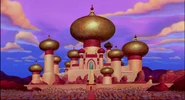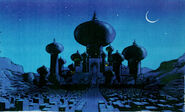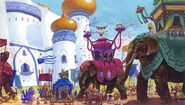| Line 95: | Line 95: | ||
Agrabah street concept art.jpg |
Agrabah street concept art.jpg |
||
Agrabah Execution Block concept art.png|Concept art of the execution block |
Agrabah Execution Block concept art.png|Concept art of the execution block |
||
| + | Agrabah Concept art (1).jpg |
||
| + | Agrabah Concept art (2).jpg |
||
| + | Agrabah Concept art (3).jpg |
||
| + | Agrabah Concept art (4).jpg |
||
| + | Agrabah Concept art (5).jpg |
||
| + | Agrabah Concept art (6).jpg |
||
| + | Agrabah Concept art (7).jpg |
||
| + | Agrabah Concept art (8).jpg |
||
</gallery> |
</gallery> |
||
Revision as of 08:55, 29 June 2020
Agrabah is a glimmering and bustling desert kingdom and one of the greatest nations of the Seven Deserts ruled by the kindly Sultan Hamed, his daughter, Princess Jasmine and his son-in-law, Aladdin. It is the main setting of the franchise.
Description

Map of Agrabah.
Agrabah is described as "a city of mystery, of enchantment", and as such, has had numerous encounters with the fantastical throughout its existence. Some of which include sorcerers, witches, genies, sandworms, flying carpets, minotaurs, elementals, ifrits and many more.
Agrabah is one of the most prominent nations of the Seven Deserts, a vast realm of deserts stretching out as far as Egypt and to the borders of Pei Ling City, and it is quite possibly its largest and most prosperous, since despite Upanistan being considered more peaceful, Getzistan more wealthy and Quirkistan more bountiful, the Ethereal's visit acknowledged Agrabah as one of the greatest civilizations in the ancient world on par with Atlantis, Babylon and Pompeii, only made truly greater than them when its future ruler Jasmine realized that Agrabah needed to start taking more care of its people.
Government
Agrabah's government has been a royal sultanate for generations, having been ruled by the royal family descended of the country's founder Sheik Hamed. All its leaders are referred to as Sultans, or Sultanas in the case of females. The Sultan is assisted by his council, which consists of various diplomats that aid the sovereign in governing the city or establishing diplomatic relations with neighboring or foreign countries. One notable councilman was Jafar, who served as The Sultan's Royal Vizier for some years.
Social Classes
Agrabah is a melting pot of social classes; the wealthy tend to live closer to the Sultan's palace, while the poor live closer to Agrabah's entry wall. Agrabah's less wealthy citizens are commonly known as "street rats" (fem. "street mouse") and are marginalized as a group. The city also has an infamous underworld, with one area, in particular, is known as the "Thieves Quarters".
Law Enforcement
Agrabah has many strict laws, mainly concerning theft. Due to the city's high crime rate, theft is dealt with in the most harshest way possible to discourage it, by threatening to cut off the hands of thieves, or even execute them, however this usually did little to discourage thieves and street rats. The city is protected by the Royal Guards, headed by Rasoul which serve multiple purposes, such as law enforcement, executioners, royal escorts, royal servants and even act as the royal army. As such, the guards serve as judge, jury and executioner, only being superseded in authority by the Sultan, his royal vizier and the princess, however the princess cannot overturn an order to the guards given by the vizier or the Sultan, and the vizier cannot overturn orders given by the Sultan.
Economy
The kingdom's primary export is jewels and silk. Despite the kingdom's seeming prosperity, water and food are not easy to grow here, as such the country mainly relies on trade to keep its citizens fed and quenched. Because of the expensive nature of food and drink, there is a clear cultural and financial divide among its people, with the poor that live near the walls of the city barely being able to afford food and are commonly referred to as "Street Rats" by the rest of the citizens for resorting to thievery. Due to these factors, Agrabah has a very notable criminal element, being home to some of the most ruthless bandits and thieves in the deserts, including the infamous Thieves' Guild. But since the coming of the Ethereal this may have changed.
Allied Kingdoms
Agrabah holds friendly diplomatic ties with many kingdoms both within and beyond the Seven Deserts which have established trade relations and supply most of the food or the necessities for Agrabah which they cannot provide for themselves.
- Odiferous: Agrabah's most trusted foreign ally and political acquaintance, with the royal families of both kingdoms being close friends, specifically Agrabah's Princess Jasmine and Prince Aladdin with Odiferous's Prince Uncouthma and Princess Brawnhilda. Odiferous primarily supplies Agrabah with an incredible excess of yak cheese which they are more than happy to give, but which Agrabah is hesitant to accept, having a large surplus of the foul-smelling dairy product.
- Quirkistan: An enchanted kingdom with bountiful crops that became allies with Agrabah after Jasmine and Aladdin reformed and befriended King Mamood.
- Getzistan: The wealthy gambling capital of the Seven Deserts which holds a friendly alliance with Agrabah.
- Upanistan: On friendly terms with Agrabah after Aladdin befriended Caliph Kapok.
- Persia: On friendly terms after befriending Scheherazade the Fifth.
- Egypt: Agrabah has friendly trade relations with Egypt.
- China: Agrabah is on friendly terms with China, with the Sultan of Agrabah and the Emperor of China being old friends and Agrabah engaging in trade with Pei Ling City. Although this relation was almost jeopardized by Prince Li.
- Isle of Galafems: Originally enemies but now on friendly terms since Queen Hippsodeth and the Sultan began dating.
- Animal Kingdom: On friendly terms after Aladdin befriended Queen Kimbla.
Unknown Status
- Ganastan: A kingdom which once wished to fortify an alliance with Agrabah, but this may have been jeopardized by the spirit of Kileem.
- Caucasus: A Russian queendom in the Frozen North which Agrabah wished to forge an alliance with, but it fell through after angering Queen Tatiana.
Places of Interest
The City
- Sultan's Palace: The home of the Sultan and Jasmine. Following his marriage to the princess, Aladdin and his friends took up residence in the palace. At night, the palace is illuminated.
- Agrabah Marketplace: The marketplace where Aladdin and his sidekick Abu were usually found when scrapping for food and ducking from guards before they became royal. Now it is a popular destination for Aladdin, Jasmine, and the others to browse and sightsee.
- Thieves Quarters: A seedy part of the city, where crooks and rogues gather to fraternize.
- The Skull and Dagger: A tavern and the primary meeting spot for all thieves in Agrabah. Thieves Guild members-only.
- Street of Forty Thieves: The main street of the Thieves Quarters where many tend to disappear. Named after the Forty Thieves.
- Sinbad Street: A street named after the legendary Sinbad.
- The Casbah: The oldest part of the city.
- Roc's Nest Row: The main street leading to the Casbah named after the Roc birds.
- Kuzia's Hideout: The home of the sorceress Kuzia guarded by One-Eye.
- Aladdin's Hovel: A run-down hovel where Aladdin spent most of his young life, with his monkey Abu. It is located far from the palace near the outer walls of the city, but its elevated placement provides a stunning view of the city.
The Desert
- Agrabahnian Desert: The vast desert territory of Agrabah located right outside the city's gates.
- Cave of Wonders: A large and mysterious cave in the shape of a tiger found in the middle of the desert just outside Agrabah's city walls. The cave holds many treasures and magical items, most notably Genie's magic lamp and the Magic Carpet.
- Amin Abahdway: A village just outside Agrabah's capital that was once plagued by Mechanicles.
- Abis Mal's Hideout: The hideaway and home of Abis Mal and Haroud Hazi Bin.
- Forbidden Valley: A dense jungle of deadly vines that once existed outside of Agrabah that was actually a sleeping plant elemental. It was however destroyed by Aladdin and Prince Uncouthma.
- Shadowed Ruins: The ruins of a long abandoned town just outside Agrabah's city walls that was once ruled by a greedy Roc.
Inhabitants
- See: Agrabahnians
History
Background
Founding
Agrabah was founded many thousands of years ago by Sheik Hamed, the ancestor of the royal family and established near the Jordan River. The Sultan's Palace was "envisioned" by Sheik Hamed and would serve as the city's iconic and most beautiful sight for centuries to come.
Reign of Amuk Moonrah
Sometime after Agrabah's founding millennia ago, the evil demon of fire Amuk Moonrah laid siege to the kingdom and took over, becoming its first and only demonic monarch, demanding tribute each day to be burned in his honor and tormenting the populace for his own amusement. Luckily, his evil reign was finally put to an end after he was sealed away in his temple by an unknown hero. His reign was eventually forgotten by history.
Sultan Kileem
The kingdom would enjoy relative peace for centuries until the coming of Sultan Kileem, Agrabah's most ruthless and evil dictator who ruled with an iron fist and conquered many territories beyond Agrabah thanks to the power of his invincible enchanted armor. His reign would come to an end only on the day of his death (the details of which little is known), on which he cast a curse upon his suit of armor so that anyone that would wear it would be possessed by his spirit. Because of this, Kileem's cruel reign was put to an end, and the royal family would hide away his armor and hide all traces of Kileem's cruel history.
Aladdin
The Return of Jafar
Aladdin: The Series
Aladdin and the King of Thieves
Other Appearances
Agrabah has appeared in every single piece of Aladdin media in the franchise.
Gallery
Concept Art
Behind the Scenes
Agrabah is based on classical Baghdad. However, it more broadly represents a wider classical Islamicate culture, which encompassed the Middle East, North Africa, Central Asia, and parts of the Indian subcontinent during this period, including Islamic empires such as the Abbasid Caliphate, Ottoman Empire, Safavid Persia, and Mughal India. Agrabah's architecture (including its palace and marketplace) was inspired by Middle Eastern architecture, which encompasses elements of Arabic, Persian and Indo-Islamic architecture. The city's royal palace and name is directly inspired by the Indian city of Agra's Taj Mahal, which was a product of Indo-Islamic Mughal architecture. Much the city was also inspired by layout supervisor Rasoul Azadani who took many pictures of his hometown of Isfahan, Iran to get a basis for what Agrabah would look like.
Trivia
- The original Arabic folk tale of Aladdin was originally set in China, specifically an Islamic city (most likely an Uyghur kingdom in the Xinjiang region).
- As revealed in "Do the Rat Thing", the Sultan rarely leaves the palace.
- In the Aladdin animated TV series, it is stated multiple times that the adjective term used to refer to something of or about Agrabah is "Agrabahnian".














